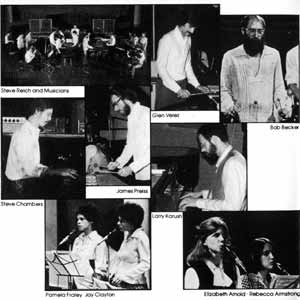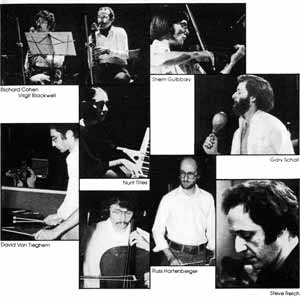
Главная
Сфера ECM
Люди
Альбомы
Ответы мэтров
Архив
Поиск
Форум
Гостевая книга
Ссылки
Благодарности
Отзывы
Авторов!
Написать
ДЖАЗ.РУ
Steve Reich "Music for 18 Musicians"
|
ECM New Series 1129 821 417-2
STEVE REICH The first sketches for "Music for 18 Musicians" were made in May 1974 and it was completed in March 1976. Although its steady pulse and rhythmic energy relate to many of my earlier works, its instrumentation, harmony and structure are new.
As to instrumentation, "Music for 18 Musicians" is new in the number and distribution of instruments; violin, cello, 2 clarinets doubling bass clarinet, 4 women's voices, 4 pianos, 3 marimbas, 2 xylophones and metallophone (vibraphone with no motor). All instruments are acoustical. The use of electronics is limited to microphones for the voices and some of the instruments.
There is more harmonic movement in the first 5 minutes of "Music for 18 Musicians" than in any other complete work of mine to date. Though the movement from chord to chord is often just a re-voicing, inversion, or relative minor or major of a previous chord, usually staying within the key signature of three sharps at all times, nevertheless, within these limits harmonic movement plays a more important role in this piece than in any other I have written.
Rhythmically there are two basically different kinds of time occuring simultaneously in "Music for 18 Musicians". The first is that of a regular rhythmic pulse in the pianos and mallet instruments that continues throughout the piece. The second is the rhythm of the human breath in the voices and wind instruments. The entire opening and closing sections plus part of all sections in between contain pulses by the voices and winds. They take a full breath and sing or play pulses of particular notes for as long as their breath will comfortably sustain them. The breath is the measure of the duration of their pulsing. This combination of one breath after another gradually washing up like waves against the constant rhythm of the pianos and mallet instruments is something I have not heard before and would like to investigate further.
The structure of "Music for 18 Musicians" is based on a cycle of eleven chords played at the very beginning of the piece and repeated at the end. All the instruments and voices play or sing pulsing notes within each chord. Instruments like the strings which do not have to breathe nevertheless follow the rise and fall of the breath by following the breath patterns of the bass clarinet. Each chord is held for the duration of two breaths, and the next chord is gradually introduced, and so on, until all eleven are played and the ensemble returns to the first chord. This first pulsing chord is then maintained by two pianos and two marimbas. While this pulsing chord is held for about five minutes a small piece is constructed on it. When this piece is completed there is a sudden change to the second chord, and a second small piece or section is constructed. This means that each chord that might have taken fifteen or twenty seconds to play in the opening section is then stretched out as the basic pulsing harmony for a five minute piece very much as a single note in a cantus firmus, or chant melody of 12th century Organum by Perotin might be stretched out for several minutes as the harmonic center for a section of the Organum. The opening eleven chord cycle of "Music for 18 Musicians" is a kind of pulsing cantus for the entire piece.
On each pulsing chord one or, on the third chord, two small pieces are built. These pieces or sections are basically either in the form of an arch (ABCDCBA), or in the form of a musical process, like that of substituting beats for rests, working itself out from beginning to end. Elements appearing in one section will appear in another but surrounded by different harmony and instrumentation. For instance the pulse in pianos and marimbas in sections 1 and 2 changes to marimbas and xylophones in section 3A, and to xylophones and maracas in sections 6 and 7. The low piano pulsing harmonies of section 3A reappear in section 6 supporting a different melody played by different instruments. The process of building up a canon, or phase relation, between two xylophones and two pianos which first occurs in section 2, occurs again in section 9 but building up to another overall pattern in a different harmonic context. The relationship between the different sections is thus best understood in terms of resemblances between members of a family. Certain characteristics will be shared but others will be unique.
One of the basic means of change or development in many sections of this piece is to be found in the rhythmic relationship of harmony to melody. Specifically, a melodic pattern may be repeated over and over again, but by introducing a two or four chord cadence underneath it, first beginning on one beat of the pattern, and then beginning on a different beat, a sense of changing accent in the melody will be heard. This play of changing harmonic rhythm against constant melodic pattern is one of the basic techniques of this piece, and one I have never used before. Its effect, by change of accent, is to vary that which is in fact unchanging.
Changes from one section to the next, as well as changes within each section are cued by the metallophone (vibraphone with no motor) whose patterns are played once only to call for movements to the next bar, much as in a Balinese Gamelan a drummer will audibly call for changes of pattern, or as the master drummer will call for changes of pattern in West African music. This is in contrast to the visual nods of the head used in earlier pieces of mine to call for changes and in contrast also to the general Western practice of having a non performing conductor for large ensembles. Audible cues become part of the music and allow the musicians to keep listening.
STEVE REICH Steve Reich was born in 1936 in New York. He graduated with honors in Philosophy from Cornell University in 1957 and subsequently studied composition with Hall 0verton 1957-'58; at the Juilliard School of Music 1958-61; and at Mill College in California, with Darius Milhaud and Luciano Berio, where he received his M.A. in Music in 1963.
In 1966 he began his own ensemble in New York with three musicians. Since that time he has performed his music extensively with this group, "Steve Reich and Musicians", now grown to eighteen musicians, throughout the United States, Canada, and Europe.
In the summer of 1970 he studied drumming with a master drummer of the Ewe tribe at the Institute for African Studies in Ghana. During the summers of 1973 and '74 he studied Balinese Gamelan Semar Pegulingan and Gamelan Gambang at the Center for World Music in Berkeley, California. Recently he has begun studying the traditional forms of cantillation (chanting) of the Hebrew Scriptures.
The composition of "Music for 18 Musicians" was supported by grants from: Mrs. Betty Freeman, The Rockefeller Foundation, The National Endowment for the Arts Grants to Composers 1974 and '76, and the New York State Council on the Arts Creative Artists Public Service Program 1974-75. The World Premiere of "Music for 18 Musicians" was presented at Town Hall in New York in April 1976 and the European Premiere was presented at the Metamusik Festival in Berlin in October of the same year. Production and Recording Supervision: Rudolph Werner / Recording Engineer: Klaus Hiemann / Mixing: Rudolph Werner, Klaus Hiemann, Steve Reich / Cover Drawing: "Weaver's Notation", Beryl Karot (1976)
Этот альбом на сайте ECM Records | Другие альбомы ECM на нашем сайте Обновление: 14.03.2004 | |||||||||


